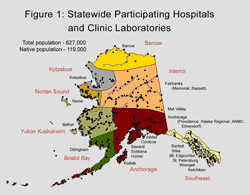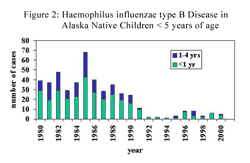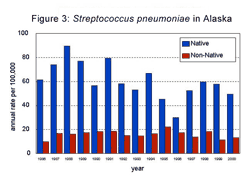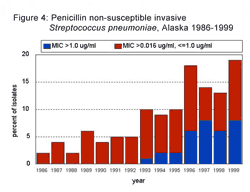Disease Surveillance
-
Sections
- Disease Surveillance Main Page
- Reports
- Publications and Forms
- Contacts and Participating Labs
- Events and Meetings
What is Disease Surveillance?
Surveillance AIP, with the help of hospitals and clinics across Alaska, operates a surveillance system to monitor the occurrence of illnesses caused by a select group of bacteria. This monitoring is done to be able to document rates of diseases caused by these organisms, to look for trends over time and across regions of the state, to provide additional laboratory testing and identification of the organisms and their specific characteristics, to provide current and historical data to aid in making and interpreting decisions that may affect public health, and to provide a basis for further study of the diseases and their occurrence in Alaska.
The surveillance begins with a case definition: illness compatible with the bacterial infection occurring in a person from whom one of the target organisms has been isolated from a normally sterile site. AIP currently conducts surveillance for illnesses caused by Streptococcus pneumoniae, Haemophilus influenzae, Neisseria meningitidis, and group A and B Streptococcus. For purposes of looking at rates of disease, the illnesses are only counted if they occur in Alaska residents who are within the State at the time of diagnosis. However for purposes of outbreak identification, all isolates are sought, whether or not they occur in residents.
The surveillance system works by having the clinical laboratories across
Alaska submit any isolate of a target organism from a normally sterile site
to AIP.  There
are currently 25 clinical laboratories in the State (Figure
1, click image for larger view) . Along with the isolate, AIP requests
basic demographic information on the patient and information on the disease
presentation, laboratory testing done at the hospital or clinic, pre-existing
or concurrent medical conditions, and when appropriate, vaccination history.
Once isolates are received at AIP they are regrown to confirm the organism
and to perform testing for susceptibility to certain antibiotics. Researchers
at AIP may collect additional information either through follow-up with clinical
personnel at the submitting facility or by performing reviews of medical records.
Some cases are also identified by notification of AIP by providers or others
involved in patient care. AIP then contacts the facility to gather the case
information and if possible to retrieve the isolate. Annually AIP sends out
lists to the participating laboratories of isolates received from them during
the previous year. Laboratory personnel are encouraged to compare the lists
to their laboratory records in order to identify any cases which may have
been missed and to report those at that time.
There
are currently 25 clinical laboratories in the State (Figure
1, click image for larger view) . Along with the isolate, AIP requests
basic demographic information on the patient and information on the disease
presentation, laboratory testing done at the hospital or clinic, pre-existing
or concurrent medical conditions, and when appropriate, vaccination history.
Once isolates are received at AIP they are regrown to confirm the organism
and to perform testing for susceptibility to certain antibiotics. Researchers
at AIP may collect additional information either through follow-up with clinical
personnel at the submitting facility or by performing reviews of medical records.
Some cases are also identified by notification of AIP by providers or others
involved in patient care. AIP then contacts the facility to gather the case
information and if possible to retrieve the isolate. Annually AIP sends out
lists to the participating laboratories of isolates received from them during
the previous year. Laboratory personnel are encouraged to compare the lists
to their laboratory records in order to identify any cases which may have
been missed and to report those at that time.
The surveillance system is the result of an evolutionary process that has
been happening since the inception of surveillance at AIP in 1980. At that
time Haemophilus influenzae type b (Hib) was responsible for about 95% of
bacterial meningitis occurring in children in the United States and was known
to be a particular problem in rural Alaska. The surveillance system was initiated
to collect all cases of Hib occurring in Alaska. Over time other serotypes
of Hi as well as non-typable Hi were added to the surveillance. Cases of Hib disease in Alaska decreased dramatically with the introduction in 1991 of conjugate vaccine
 for use infants (Figure 2,
click image for larger view). Since that time the surveillance system
has provided a way to monitor the effects of changes in the vaccination program
and to attempt to refine control programs. No cases of Hib were seen in Alaska
Native children < 5 years of age in 2001.
for use infants (Figure 2,
click image for larger view). Since that time the surveillance system
has provided a way to monitor the effects of changes in the vaccination program
and to attempt to refine control programs. No cases of Hib were seen in Alaska
Native children < 5 years of age in 2001.
Statewide surveillance for Streptococcus pneumoniae began
in 1986. Since that time the number of cases identified annually has varied
from a low of 97 in 1986 to a high of 165 in 1991. The majority of the cases
are of pneumonia, but meningitis, pericarditis, empyema, epiglotittis, septic
arthritis, cellulitis, bactertemia,  and septic shock are also seen. Alaska Natives have consistently had a higher
rate of disease than non-Natives in Alaska (Figure
3, click image for larger view). The highest rates of disease are seen
for children < 2 years of age (189/100,000 population for the year 2000),
with the next highest rate among persons aged 65 years and older (56/100,000
population for 2000). As has been seen elsewhere, the occurrence disease caused
by Streptococcus pneumoniae that are resistant to penicillin has been increasing
(Figure 4, click
image for larger view).
and septic shock are also seen. Alaska Natives have consistently had a higher
rate of disease than non-Natives in Alaska (Figure
3, click image for larger view). The highest rates of disease are seen
for children < 2 years of age (189/100,000 population for the year 2000),
with the next highest rate among persons aged 65 years and older (56/100,000
population for 2000). As has been seen elsewhere, the occurrence disease caused
by Streptococcus pneumoniae that are resistant to penicillin has been increasing
(Figure 4, click
image for larger view).  The
first isolates in Alaska with MIC (minimum inhibitory concentration) >1.0
µc/ml for penicillin were seen in 1993 and the percent of isolates with
this characteristic has continued to increase.
The
first isolates in Alaska with MIC (minimum inhibitory concentration) >1.0
µc/ml for penicillin were seen in 1993 and the percent of isolates with
this characteristic has continued to increase.
During the 1990s surveillance was expanded to include disease caused by invasive Neisseria meningitidis, and group A and B Streptococcus.
| Alaska, 2000 | US Active Bacterial Disease Core Surveillance, 2000 | ||
|---|---|---|---|
| cases | rate/100,000 | ||
| Neisseria meningitidis |
9
|
1.4
|
0.8/100,000
|
| Group A Streptococcus |
18
|
2.9
|
3.2/100,000
|
| Group B Streptococcus |
18
|
2.9
|
6.9/100,000
|
| Rates of disease are similar for Native and non-Natives for Neisseria meningitidis and Group B Streptococcus. For Group A Streptococcus, Natives had a significantly higher rate of disease, 8.4/100,000 per year, than non-Natives, 1.5/100,000 per year (p<.001). | |||




